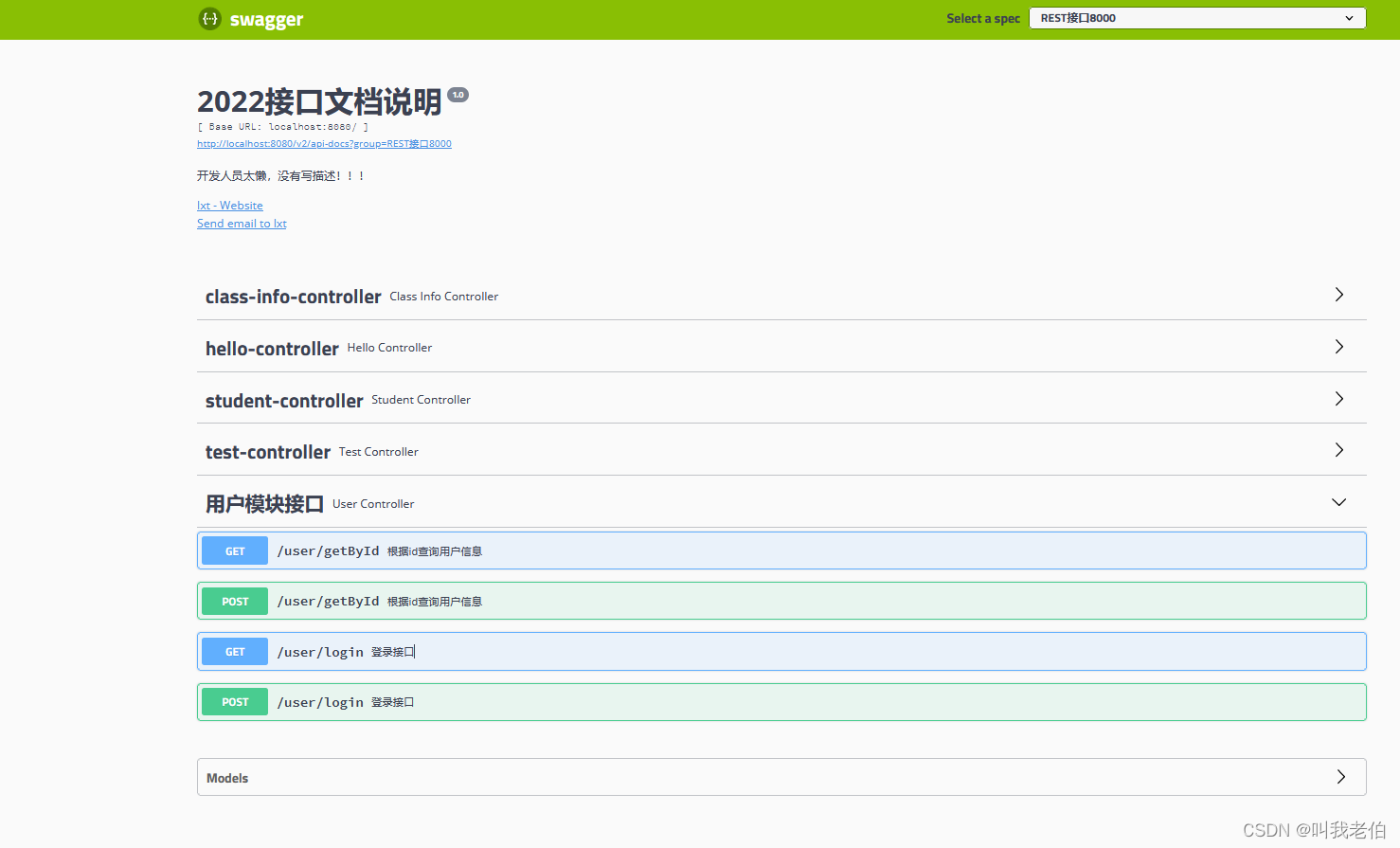一、添加依赖
<!-- https://mvnrepository.com/artifact/io.springfox/springfox-swagger-ui -->
<dependency>
<groupId>io.springfox</groupId>
<artifactId>springfox-swagger-ui</artifactId>
<version>2.9.2</version>
</dependency>
<!-- https://mvnrepository.com/artifact/io.springfox/springfox-swagger2 -->
<dependency>
<groupId>io.springfox</groupId>
<artifactId>springfox-swagger2</artifactId>
<version>2.9.2</version>
</dependency>二、添加配置
在我们的application.yaml 添加配置
swagger:
title: xxx项目RESTful API
description: 开发人员太懒,没有写描述
version: 1.0
contactName: lxt
contactEmail:
contactUrl:
basePackageRest: com.qcby.xxx.rest
termsOfServiceUrl:在我们的config配置包下添加SwaggerProperties.java文件
@Component
@ConfigurationProperties(prefix = "swagger")
@Data
public class SwaggerProperties {
private String title;
private String contactName;
private String contactUrl;
private String contactEmail;
private String version;
private String description;
private String basePackageRest;
private String termsOfServiceUrl;
}再建立SwaggerConfig.java
@Configuration
@EnableSwagger2
public class SwaggerConfig {
@Autowired
private SwaggerProperties swaggerProperties;
@Bean
public Docket createRestApi() {
return new Docket(DocumentationType.SWAGGER_2)
.groupName("REST接口8000")
.apiInfo(apiInfo())
.select()
// 配置自动扫描那些包下类型生成接口文档
.apis(RequestHandlerSelectors.basePackage(swaggerProperties.getBasePackageRest()))
.build();
}
//构建 api文档的详细信息函数,注意这里的注解引用的是哪个
private ApiInfo apiInfo() {
return new ApiInfoBuilder()
//页面标题
.title(swaggerProperties.getTitle())
//创建人
.contact(new Contact(swaggerProperties.getContactName(), swaggerProperties.getContactUrl(),swaggerProperties.getContactEmail()))
//版本号
.version(swaggerProperties.getVersion())
//描述
.description(swaggerProperties.getDescription())
.build();
}
}另外其他类中的注解加方法
// controller类
@Api(value = "通用接口", tags = {"通用接口"})
// 方法
@ApiOperation("演示接口")
// 参数
@ApiImplicitParams(
{@ApiImplicitParam(name = "Authorization",
value = "Authorization token", required = true,
dataType = "string", paramType = "header")}
)
// 实体类
@ApiModel("用户实体")
// 实体类字段
@ApiModelProperty(value = "创建时间")拦截器不拦截接口文档(拦截则需要登录后可以登录)
如果需要不登陆即可访问,才需要配置(可选)
@Override
public void addInterceptors(InterceptorRegistry registry) {
registry.addInterceptor(loginInterceptor()).addPathPatterns("/**")
// 那些路径不拦截
.excludePathPatterns("/login/**","/error"
,"/swagger-ui.html/**","/swagger-resources/**");
}三、测试
接口文档地址:http://localhost:8080/swagger-ui.html


 Springfox Swagger2配置与使用指南
Springfox Swagger2配置与使用指南





 本文档详细介绍了如何在Spring Boot项目中集成并配置Springfox Swagger2,以生成RESTful API的文档。首先,添加了Swagger的相关依赖,接着在`application.yaml`中配置Swagger的基本信息,并创建了`SwaggerProperties`和`SwaggerConfig`类进行进一步的定制。在`SwaggerConfig`中,定义了API的元数据,并通过`Docket`选择要生成文档的包路径。此外,还展示了如何使用注解来标注控制器、方法、参数及实体类。最后,提供了接口文档的访问地址,并提到了如何配置拦截器以允许未登录用户访问Swagger UI。
本文档详细介绍了如何在Spring Boot项目中集成并配置Springfox Swagger2,以生成RESTful API的文档。首先,添加了Swagger的相关依赖,接着在`application.yaml`中配置Swagger的基本信息,并创建了`SwaggerProperties`和`SwaggerConfig`类进行进一步的定制。在`SwaggerConfig`中,定义了API的元数据,并通过`Docket`选择要生成文档的包路径。此外,还展示了如何使用注解来标注控制器、方法、参数及实体类。最后,提供了接口文档的访问地址,并提到了如何配置拦截器以允许未登录用户访问Swagger UI。

















 20万+
20万+

 被折叠的 条评论
为什么被折叠?
被折叠的 条评论
为什么被折叠?










